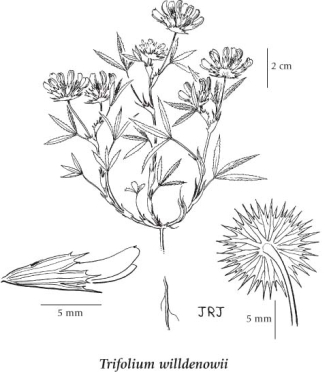"Anthocyanin leaf spots in [this species] are controlled by a single gene, with the allele for spots dominant, just as in
blue-eyed Mary (Collinsia parviflora). Phenotypically identical single-gene polymorphisms are also known in white and rose clover. two Old World perennil species introduced in North America. We have observed polymorphic populations of annual clover primarily on the Flat Top Islands, where the frequencies of spotted plants in populations parallells that found in blue-eyed Mary and monkey flower.
"On Carlos Island the frequency of spotted plants is particularly striking. The plants occur across the island from north to south, and the frequency of the spotted morph is high on the cold, windy north side, increases up to the crest of the island, and decreases on the sheltered south slope of the island. A gradual change in genotype or phenotype frequencies along an environmental or geographical gradient is called a cline. Spotted leaves in T. willdenowii on this line across Carlos Island are a good example of a cline, albeit one that involves a very short distance.
"The gradual change in gene frequency along the cline is probably caused by two factors. First is the change in temperature and exposure that selects for spotted morphs in cold, windy sites and spotless morphs in warmer, sheltered sites. Second, the distance involved is so short that genes for spotted leaves from the north side are likely to be dispersed northward, either in pollen transferred by pollinators or by seed dispersal. Since [this species] is a normally self-pollinated species, seed dispersal is the most important way in which such gene movement could occur."
Source: Griffiths and Ganders. 1983. Wildflower Genetics: A Field Guide for British Columbia and the Pacific Northwest.
